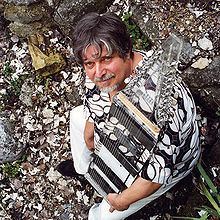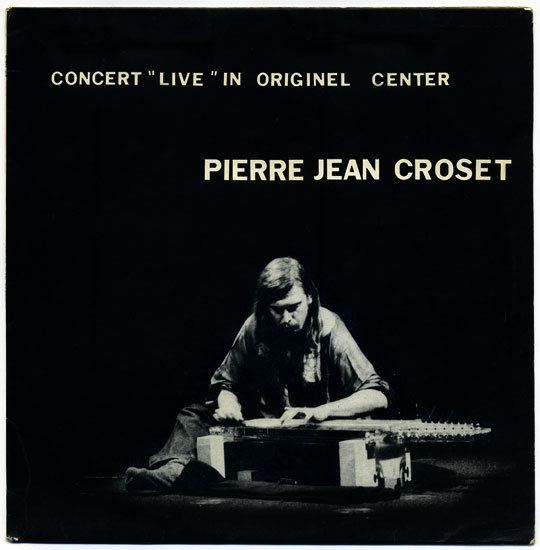Name Pierre-Jean Croset | Role Composer | |
 | ||
Albums L'art de la lyre harmonique | ||
Pierre Jean Croset: First Hour
Pierre-Jean Croset (born July 14, 1949 in Grenoble, France) is a composer, an interpreter, a stringed-instrument maker and a French musicologist.
Contents
- Pierre Jean Croset First Hour
- The musician
- The Musical instrument Maker
- The Musicologist
- Written Articles
- Books
- Radio programs
- Concerts
- Themed Music
- Discography
- References

The musician
As a young boy, Pierre-Jean Croset was introduced to music theory by his mother who taught Literature and was a classical pianist. At the age of seven, he took private piano lessons with professor and composer Paul Pittion in Grenoble for six years. He also began to play the guitar at the age of thirteen. In 1969, he was the guitarist for a jazz group in Lyon.
Having earned a university degree in history and geography in 1970, he decided to specialize in musicology. He received his doctorate and graduated summa cum laude in 1991, supervised by the musicologist and philosopher Daniel Charles (Paris VIII). His thesis titled "By Going Back up Mugu Karnali, essay on the Music of Spheres" explores the relationship between music and spirituality. Fascinated by John Cage, he studied his famous "Notations" for several years.
In January 1976, he was invited by Maurice Fleuret to be part of the "The Stand of the Young composers" at the Museum of Modern Art of Paris. Later he obtained a research grant from the Ministry of Culture (1982) to study the music and instruments of Bali and Central Java.
Thanks to the "Villa Medicis" "hors les murs" grant which he received in 1984, he travelled to the University of California in San Diego where he performed and lectured at the Center for Music Experiment in addition to Berkeley, Stanford, Oakland Mills College and UCLA. In 1975, he settled down in Provence where he performed in concerts for several years. During the Festival d'Avignon in 1985, he exhibited his musical instruments and performed for the Chartreuse of Villeneuve-lès-Avignon. Later he journeyed to the East to study its local instrumental productions: during 1986 in Nepal, 1987 in North India, 1988 in South India and in Indonesia during 1997 and 2002.
From 1970 till 1982, he studied a large number of western and oriental traditional instruments to establish which one corresponded best to his wants. As a proponent of a new stringed-instrument trend in improved acoustics, he decided to create his own instruments, "harmonic lyres" and guitars that delivered deeply harmonious natural sounds due to the specific choice of Savarez strings and isolation materials which do not produce interferences (this is due to the carbon fiber and the "altuglas " P.M.M.A. (cast) - manufactured by'Altuglas International').
Giving free rein to his numerous musical projects and his video documentaries, he also became known for his new sound installations for gardens, and he created the association "Atelier de Création Musique et Paysage".
The Musical instrument Maker
The stringed-instrument maker, Pierre-Jean Croset, is the son of an engineer father and inventor who worked for Altulor: a company that produced synthetic materials. As a result, during his childhood, Croset discovered the properties of a kind of PMMA named "Altuglas" (diffuser of light, transparent and bright) by diverting the usage of a PMMA blowpipe.
After having thought for a long time about John Cage's remark: " to create new music it is necessary to create new tools", he was directed by the researcher and acoustician Émile Leipp, director of the Laboratory of Musical Acoustic ( CNRS) of the University of Jussieu,Paris.He focused on creating a revolutionary instrument that would enable him to create music.
In 1974, his first glass Harmonic Lyre made with PMMA altuglas cast was designed. He had the opportunity to play this instrument at the tenth Biennial event of Paris in 1977 at the Museum of Modern Art in Paris. This electroacoustic lyre consists of 18 strings and at least two micro-sensors for each of the strings. By 2010, he had successfully designed four harmonic lyres, 3 glass guitars of PMMA and carbon fiber neck, "water drums" for John Cage's creation with the " percussions of Strasbourg" (1989), as well as various other original instruments which include musical wind mills, wind chimes, kalimbé, musical jackstraw in bamboo for children, musical boomerangs,an acoustic game of bowls, and so on.
In 1986, he designed a musical instrument named "Geophone" for the city of music in Paris. The following year, he created a design of a PMMA Sarod for the musician Amjad Ali Kahn.
The Musicologist
In 1987, having been fascinated by oriental cultures and having studied, in particular, Nepalese, Indonesian and Hindi cultures, he met with ethnomusicologist Alain Daniélou whose works he had been studying for over fifteen years. Daniélou taught Croset the principles concerning the study of musical scales, musical semantics and the comparative table of musical intervals.
As a musicologist and musician, he is particularly interested in the effects produced by sound according to the laws of audition, coupled with the double physiological and mental aspect. He defines this combination as " the just intonation ". This "just intonation" is evident (it opposes " the tempered intonation ") in traditional musical cultures. While in India, in particular Southern India, he collected numerous data on certain pillars of temples, the intrinsic properties of which are musical and which do not receive the recognition of this country (data collected from the temples of Tamil Nadu). For this study, he was awarded the "Romain Rolland" prize by the Foreign office (France) in 1987.
The musician, the stringed-instrument maker and the musicologist are three additional aspects of the personality of Pierre-Jean Croset, whose work on the harmonics parallels studies by David Hykes in the U.S.A, Roberto Laneri in Italy, Michael Vetter in Germany and Tran Quang Hai in Vietnam. Since 1991, he has studied "musical and landscape art " which includes the sound of plants and trees.
